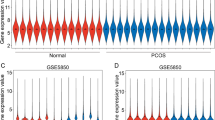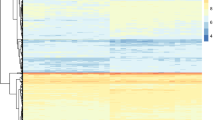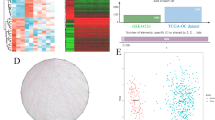Abstract
Purpose
Polycystic ovary syndrome (PCOS) is one of the most common endocrine and metabolic disorders, posing a serious threat to the health of women. Herein, we aimed to explore new biomarkers and potential therapeutic targets for PCOS by employing integrated bioinformatics tools.
Methods
Three gene expression profile datasets (GSE138518, GSE155489, GSE106724) were obtained from the Gene Expression Omnibus database and the differentially expressed genes in PCOS and normal groups with an adjusted p-value < 0.05 and a |log fold change (FC) | > 1.2 were first identified using the DESeq package. The weighted correlation network analysis (WGCNA) R package was used to identify clusters of highly correlated genes or modules associated with PCOS. Protein-protein interaction (PPI) network analysis and visualization of genes in the key module were performed using the STRINGdb database and the NetworkX package (edge > 5), respectively. The genes overlapping among the key module genes and PCOS-associated genes were further analyzed. Ligand molecules with strong binding energy < −10 kJ/mol to GNB3 were screened in the drug library using MTiOpenScreen. AutoDock, ChimeraX, and BIOVIA Discovery Studio Visualizer were further used to elucidate the mechanism of ligand interaction with GNB3. Finally, the relationship between GNB3 and PCOS was verified using experimental models in vivo and in vitro.
Results
Of the 11 modules identified by WGCNA, the black module had the highest correlation with PCOS (correlation = 0.96, P = 0.00016). The PPI network of 351 related genes revealed that VCL, GNB3, MYH11, LMNA, MLLT4, EZH2, PAK3, and CHRM1 have important roles in PCOS. The hub gene GNB3 was identified by taking the intersection of PCOS-related gene sets. MTiOpenScreen revealed that five compounds interacted with GNB3. Of these five, compound 1 had the strongest binding ability and can bind amino acids in the WD40 motif of GNB3, which in turn affects the function of the G protein-coupled receptor β subunit. GNB3 was also significantly downregulated in PCOS models.
Conclusion
We identified the hub gene GNB3 as the most important regulatory gene in PCOS. We suggest that compound 1 can target the WD40 motif of GNB3 to affect related functions and must be considered as a lead compound for drug development. This study will provide new insights into the development of PCOS-related drugs.







Similar content being viewed by others
Data availability
The data that support the findings of this study are available online. Contact with correspondence author for any data and material on reasonable request.
Abbreviations
- PCOS:
-
Polycystic ovary syndrome
- GCs:
-
Granulosa cells
- DEGs:
-
Differentially expressed genes
- BMI:
-
Body mass index
- WGCNA:
-
Weighted gene co-expression network analysis
- GEO:
-
Gene Expression Omnibus
- GO:
-
Gene ontology
- KEGG:
-
Kyoto Encyclopedia of Genes and Genomes
- PPI:
-
Protein–Protein Interaction.
References
L.G. Cooney, A. Dokras, Beyond fertility: Polycystic ovary syndrome and long-term health. Fertil. Steril. 110, 794–809 (2018)
O. Osibogun, O. Ogunmoroti, E.D. Michos, Polycystic ovary syndrome and cardiometabolic risk: Opportunities for cardiovascular disease prevention. Trends Cardiovascular Med. 30, 399–404 (2020)
E.M. Heijnen, M.J. Eijkemans, E.G. Hughes, J.S. Laven, N.S. Macklon, B.C. Fauser, A meta-analysis of outcomes of conventional IVF in women with polycystic ovary syndrome. Hum. Reprod. Update 12, 13–21 (2006)
M.L. Pfieffer, Polycystic ovary syndrome: An update. Nursing 49, 34–40 (2019)
S.U.A. Rasool, S. Ashraf, M. Nabi, F. Rashid, K.M. Fazili, S. Amin, Elevated fasting insulin is associated with cardiovascular and metabolic risk in women with polycystic ovary syndrome. Diabetes Metab. Syndr. 13, 2098–2105 (2019)
R.P. Crespo, T. Bachega, B.B. Mendonça, L.G. Gomes, An update of genetic basis of PCOS pathogenesis. Arch. Endocrinol. Metab. 62, 352–361 (2018)
E. Stener-Victorin, Q. Deng, Epigenetic inheritance of polycystic ovary syndrome - challenges and opportunities for treatment. Nat. Rev. Endocrinol. 17, 521–533 (2021)
D.H. Abbott, M. Kraynak, D.A. Dumesic, J.E. Levine, In utero androgen excess: A developmental commonality preceding polycystic ovary syndrome? Front. Horm. Res. 53, 1–17 (2019)
D. Dewailly, [Physiopathology of polycystic ovary syndrome]. Annales d’endocrinologie 60, 123–130 (1999)
G. Pei, L. Chen, W. Zhang, WGCNA application to proteomic and metabolomic data analysis. Methods Enzymol. 585, 135–158 (2017)
B. Zhang, S. Horvath, A general framework for weighted gene co-expression network analysis. Stat. Appl. Genet. Mol. Biol. 4, Article17 (2005)
P. Langfelder, S. Horvath, WGCNA: An R package for weighted correlation network analysis. BMC Bioinforma. 9, 559 (2008)
J.S. Amberger, C.A. Bocchini, F. Schiettecatte, A.F. Scott, A. Hamosh, OMIM.org: Online Mendelian Inheritance in Man (OMIM®), an online catalog of human genes and genetic disorders. Nucleic acids Res. 43, D789–798 (2015)
S. Federhen, The NCBI taxonomy database. Nucleic acids Res. 40, D136–143 (2012)
Z. Mao, T. Li, H. Zhao, Y. Qin, X. Wang, Y. Kang, Identification of epigenetic interactions between microRNA and DNA methylation associated with polycystic ovarian syndrome. J. Hum. Genet. 66, 123–137 (2021)
J. Li, H. Chen, M. Gou, C. Tian, H. Wang, X. Song, D.L. Keefe, X. Bai, L. Liu, Molecular features of polycystic ovary syndrome revealed by transcriptome analysis of oocytes and cumulus cells. Front. Cell Developmental Biol. 9, 735684 (2021)
L. Jin, Q. Yang, C. Zhou, L. Liu, H. Wang, M. Hou, Y. Wu, F. Shi, J. Sheng, H. Huang, Profiles for long non-coding RNAs in ovarian granulosa cells from women with PCOS with or without hyperandrogenism. Reprod. biomedicine online 37, 613–623 (2018)
A. Alameer, D. Chicco. geoCancerPrognosticDatasetsRetriever, a bioinformatics tool to easily identify cancer prognostic datasets on Gene Expression Omnibus (GEO). (Bioinformatics, Oxford, England), 2021)
Gene Ontology Consortium: going forward. Nucleic Acids Res. 43, D1049–1056 (2015)
M. Kanehisa, S. Goto, KEGG: Kyoto encyclopedia of genes and genomes. Nucleic acids Res. 28, 27–30 (2000)
J. Piñero, J. Saüch, F. Sanz, L.I. Furlong, The DisGeNET cytoscape app: Exploring and visualizing disease genomics data. Computational Struct. Biotechnol. J. 19, 2960–2967 (2021)
J.D. Storey, R. Tibshirani, Statistical significance for genomewide studies. Proc. Natl. Acad. Sci. USA 100, 9440–9445 (2003)
D. Szklarczyk, A.L. Gable, D. Lyon, A. Junge, S. Wyder, J. Huerta-Cepas, M. Simonovic, N.T. Doncheva, J.H. Morris, P. Bork, L.J. Jensen, C.V. Mering, STRING v11: Protein-protein association networks with increased coverage, supporting functional discovery in genome-wide experimental datasets. Nucleic Acids Res. 47, D607–d613 (2019)
C.M. Labbé, J. Rey, D. Lagorce, M. Vavruša, J. Becot, O. Sperandio, B.O. Villoutreix, P. Tufféry, M.A. Miteva, MTiOpenScreen: A web server for structure-based virtual screening. Nucleic Acids Res. 43, W448–454 (2015)
O. Trott, A.J. Olson, AutoDock Vina: Improving the speed and accuracy of docking with a new scoring function, efficient optimization, and multithreading. J. Computational Chem. 31, 455–461 (2010)
H. Kemmish, M. Fasnacht, L. Yan, Fully automated antibody structure prediction using BIOVIA tools: Validation study. PloS one 12, e0177923 (2017)
E.F. Pettersen, T.D. Goddard, C.C. Huang, E.C. Meng, G.S. Couch, T.I. Croll, J.H. Morris, T.E. Ferrin, UCSF ChimeraX: Structure visualization for researchers, educators, and developers. Protein science: a publication of the Protein. Society 30, 70–82 (2021)
A.M.S. Riel, D.A. Decato, J. Sun, C.J. Massena, M.J. Jessop, O.B. Berryman, The intramolecular hydrogen bonded-halogen bond: A new strategy for preorganization and enhanced binding. Chem. Sci. 9, 5828–5836 (2018)
Y.L. Yang, L.F. Sun, Y. Yu, T.X. Xiao, B.B. Wang, P.G. Ren, H.R. Tang, J.V. Zhang, Deficiency of Gpr1 improves steroid hormone abnormality in hyperandrogenized mice. Reprod. Biol. Endocrinol.: RBE 16, 50 (2018)
A.C. Ozdemir, G.M. Wynn, A. Vester, M.N. Weitzmann, G.N. Neigh, S. Srinivasan, M.K. Rudd, GNB3 overexpression causes obesity and metabolic syndrome. PloS one 12, e0188763 (2017)
C. Xu, J. Min, Structure and function of WD40 domain proteins. Protein cell 2, 202–214 (2011)
M. Schapira, M. Tyers, M. Torrent, C.H. Arrowsmith, WD40 repeat domain proteins: a novel target class? Nat. Rev. Drug Discov. 16, 773–786 (2017)
B.P. Jain, S. Pandey, WD40 Repeat Proteins: Signalling scaffold with diverse functions. Protein J. 37, 391–406 (2018)
V. Migliori, M. Mapelli, E. Guccione, On WD40 proteins: Propelling our knowledge of transcriptional control? Epigenetics 7, 815–822 (2012)
M.A. Villamil, Q. Liang, Z. Zhuang, The WD40-repeat protein-containing deubiquitinase complex: catalysis, regulation, and potential for therapeutic intervention. Cell Biochem. Biophys. 67, 111–126 (2013)
H. Tummala, S. Fleming, P.M. Hocking, D. Wehner, Z. Naseem, M. Ali, C.F. Inglehearn, N. Zhelev, D.H. Lester, The D153del mutation in GNB3 gene causes tissue specific signalling patterns and an abnormal renal morphology in Rge chickens. PloS one 6, e21156 (2011)
S. Klenke, M. Kussmann, W. Siffert, The GNB3 C825T polymorphism as a pharmacogenetic marker in the treatment of hypertension, obesity, and depression. Pharmacogenetics genomics 21, 594–606 (2011)
K.D. Ko, K.K. Kim, H.S. Suh, I.C. Hwang, Associations between the GNB3 C825T polymorphism and obesity-related metabolic risk factors in Korean obese women. J. endocrinological Investig. 37, 1117–1120 (2014)
H.F. Escobar-Morreale, Polycystic ovary syndrome: Definition, aetiology, diagnosis and treatment. Nat. Rev. Endocrinol. 14, 270–284 (2018)
W.A. March, V.M. Moore, K.J. Willson, D.I. Phillips, R.J. Norman, M.J. Davies, The prevalence of polycystic ovary syndrome in a community sample assessed under contrasting diagnostic criteria. Hum. Reprod. (Oxf., Engl.) 25, 544–551 (2010)
Y. Zhu, X. Lin, X. Zong, S. Han, M. Wang, Y. Su, L. Ma, X. Chu, C. Yi, Q. Zhao, B. Wu, Structural basis of FPR2 in recognition of Aβ(42) and neuroprotection by humanin. Nat. Commun. 13, 1775 (2022)
Z. Wu, Y. Wen, G. Fan, H. He, S. Zhou, L. Chen, HEMGN and SLC2A1 might be potential diagnostic biomarkers of steroid-induced osteonecrosis of femoral head: study based on WGCNA and DEGs screening. BMC Musculoskelet. Disord. 22, 85 (2021)
Acknowledgements
We appreciate members of Nucleic Acid Medicine of Luzhou Key Laboratory for discussions throughout the study. We thank Bullet Edits Limited for the linguistic editing and proofreading of the manuscript.
Author contributions
J.Y., C.Z. and G.Q. conceived and designed the study. J.Y. and J.X. wrote the manuscript. G.Q. and X.L. completed data collection and management. All authors contributed and approved the manuscript.
Funding
This research was supported by Southwest Medical University Research Program (2020ZRQNA044 and 2020ZRQNB036) to J.Y. and G.Q. This work was supported by the research start-up fund of Southwest Medical University (No. 00170031) to J.Y. The investigation was also supported by the Central Nervous System Drug Key Laboratory of Sichuan Province (No# 200015-01SZ) to G.Q.
Author information
Authors and Affiliations
Corresponding authors
Ethics declarations
Conflict of interest
The authors declare no competing interests.
Ethics approval and consent to participate
Ethical approval was obtained to report on the patients involved as all databases used in this study are public databases. The animal experiments were performed under the approval of the Animal Care and Use Committee of Southwest Medical University.
Additional information
Publisher’s note Springer Nature remains neutral with regard to jurisdictional claims in published maps and institutional affiliations.
Rights and permissions
Springer Nature or its licensor holds exclusive rights to this article under a publishing agreement with the author(s) or other rightsholder(s); author self-archiving of the accepted manuscript version of this article is solely governed by the terms of such publishing agreement and applicable law.
About this article
Cite this article
Qiao, G., Xing, J., Luo, X. et al. Integrated bioinformatics analysis and screening of hub genes in polycystic ovary syndrome. Endocrine 78, 615–627 (2022). https://doi.org/10.1007/s12020-022-03181-x
Received:
Accepted:
Published:
Issue Date:
DOI: https://doi.org/10.1007/s12020-022-03181-x




